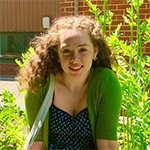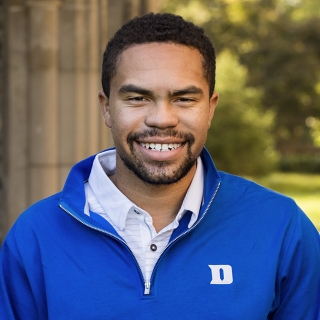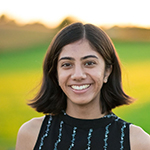
The bad news about the energy transition, according to Dr. Matthew Huber, is that it’s not happening. At least, not at the scale we need it to. A June report stated that the share of fossil fuels in the world’s total energy mix is still about 80%, as it has been for several decades. “We still live in a system fueled by fossil fuels,” Huber said.


On October 18, Huber, author of Lifeblood: Oil, Freedom, and the Forces of Capital and a professor at Syracuse University, joined Dr. Imre Szeman, author of On Petrocultures: Globalization, Culture, and Energy and professor at the University of Waterloo, and Dr. Jennifer Wenzel, author of The Disposition of Nature: Environmental Crisis and World Literature and professor at Columbia University.
Moderated by Dr. Ranjana Khanna, professor and director of the John Hope Franklin Humanities Institute here at Duke, the panel discussion “What Can the Humanities Contribute to the Global Energy Transition?” explored the potential of humanities fields to help supplement perspectives offered by the sciences, teaching us about new ways of living for a greener world.

Khanna posed the titular question: what do the panelists think that the humanities have to contribute to the energy transition?
Huber responded that in dealing with climate disaster, the “critical issue of our time,” there’s a civic responsibility to engage with the “public and political struggle” for change.
Humanities scholars excel in the art of persuasion and argumentation, and they can use that in public forms, like the Op-Ed and social media. Whereas the public conversation is skewed towards economics and engineering, humanities scholars can emphasize the equally important political and cultural barriers toward the energy transition.
Huber also called on history scholars to help recover the “deleted history” of what is politically possible.
“After four decades of neoliberalism we’ve forgotten what the public sector can actually do,” Huber said, “but when we remember the Soviet-style planned economy during World War II, and the New Deal, we recover that these large mass scale transformations have happened, and are possible,” Huber said. He also lamented that the social movements of today’s Left have become “atomized, neutralized, and largely ineffective” such that “students don’t believe in large-scale social change anymore.” With public history, activists can show how and why struggles of abolition have won in the past, and how that could be applied to the struggle for carbon abolition.
As the Climate Critic in the Green Party of Canada’s Shadow Cabinet, Dr. Imre Szeman drafted the Green Party’s proposal for the energy transition. He says that upon seeing the recommendation to end all production of fossil fuels, journalists asked Szeman, “Is this realistic? Here? Now?” They seemed to view such a change as “impossible — even though they might want it.”
Szeman argued that whether climate solutions are considered ‘realistic’ isn’t so much a question of cost, but of “our ability to conceptualize another way of being in the world,” which is where humanities fields come into play. He then posed a series of questions, including “What do we love about our current habits and behaviors? Who is culpable for the carbon dioxide in the atmosphere? How did we get here, and what does this say about our ability to get somewhere else?” He said that the role of the humanities in the energy transition is to answer all of these questions — and to remind us of the need to ask them in the first place.
Wenzel agreed, explaining that energy humanities can help us examine the literary and cultural narratives that shape our experience. She explained that fossil fuels enable a “chain of ease” wherein the primary mode of thinking about fossil fuels in everyday life is not thinking at all. She discussed the oil inventory activity she does with her students, where they account for the ubiquitous significance of oil in their lives. We develop an “embodied attachment” to the things that oil makes possible — the smoothness of plastic, the speed of auto, the smell of a butane stove. This leads us to an “impasse: we know where we stand, but we’re unable or unwilling to take action at the scale we know we need to.”
Wenzel explained that the oil inventory was actually invented by the oil industry with an insidious intention — to get consumers to consider the indispensability of petroleum products in their lives “to produce wonder and appreciation.” She showed the audience an Exxon commercial, in which scenes of vast, interconnected energy grids play across the screen as a soothing voice tell us, “you don’t need to think about the energy that makes our lives possible. Because we do.”
Wenzel emphasized that the effect of rhetoric like Exxon’s is to “ensure passivity.” The lesson? When we take stock of the impact of oil on our lives, how we use that information matters most. Climate activists must reclaim the oil inventory to “disrupt habits of mind” rather than entrench them.
Khanna noted that one of the humanities’ core methods is a “revelatory gesture of critique,” and asked the panelists what they thought about “moving past that initial gesture, toward some broader consensus for change.”
Wenzel said that doing the work of the oil inventory is powerful, but “not the last move.” We must make other moves, and in terms of thinking about what we might do otherwise, we must take care to be “forward thinking, but deeply, critically, historically informed.”
Huber said that we need to interrogate the “politics that attach oil to life,” because it’s a strategy of moving politics away from work, production, and who decides its conditions. Production today feels invisible — it’s offshore, outsourced — so that we fail to ask questions about who’s controlling it, and to what effect. He called upon the 1930s, when a “radical politics of production was on the table,” and said that climate-conscious humanities scholars need to work to recover this history.
Szeman had one “next move,” in the words of Wenzel: to realize that oil companies in the US are private, unlike in much of the rest of the world. “There’s a decision made very early on” about how and in what quantities oil is to be used — a decision that could be amenable to change.
Khanna opened the panel to questions. One audience member asked about how to advocate for an energy transition in light of the fact that capitalism is ultimately responsible for much of the status quo and the damage it has caused. How can humanities scholars critique the status quo without critiquing capitalism to the point of suspicion from would-be supporters?
Szeman emphasized the need for recognition that there are some things that one can do in the political sphere, and some things one can’t. Even though the Green Party falls squarely on the political left, “we don’t explicitly criticize capitalism right off the bat, because that doesn’t seem like the winning position.” It’s important to give voice to discussions about change “to the extent possible within the official political sphere.”
Wenzel told the audience about giving a talk on energy humanities at the Pipeline Safety Trust conference. She had to “stand in front of the oil industry” — regulators, landowners, executives — which meant “thinking about which values and assumptions to share.” By establishing credibility, she could “make conversations about this problem, which implicates all of us, possible” — despite their different perspectives.
Huber contended that when the enemy is as abstract as the quasi-global system of capitalism, it can “induce paralysis.” He’s “not sure we can absolish capitalism on the time scale” necessary for the energy transition. He quipped that the earth is not dying, it’s being killed, and “those who are killing it have names and addresses.” Those people are the target, he said — just as in the abolition of slavery, when the target of struggle was the slave owning class, another oligarchical power representing about 1% of the population. Although he supports a systemic critique of capitalism, right now “we need to be more concrete. These people have names and addresses,” he reiterated.
Another audience member asked about how to “break down the concepts of beauty and pleasure” that support the current oil regime.
Huber discussed the need for “low-carbon luxury” and an investment in open green space as part of any Green New Deal. Climate politics has often been about “shame, fear, guilt, sacrifice,” he said, and “we’re not going to win on that.” A beautiful, pleasurable vision of the future is what’s needed to win people over.
Wenzel identified the role of literature in “collecting and borrowing” ideas of beauty, arguing that beauty is always constructed. To those who view renewable energy, like wind and solar, as an eyesore, Wenzel posed the question: “Are oil spills ‘beautiful’?” (Take a glimpse.)
Someone asked a question about science fiction’s ability to “dream futures into being” — what should humanities scholars aspire to read and write?
Wenzel said that there are many ways to think about the future, and that apocalyptic renditions of science fiction are essentially “practicing for possible bad futures.” Huber agreed, stating that apocalyptic visions can be galvanizing — but there must be a positive vision that wins people over (he pointed to AOC’s “Message From the Future”).
Szeman said that utopian narratives tend to say more about the viewpoint by which a fictional world is considered a utopia than a “prescriptive way to get there,” and suggested that humanities scholars interested in fiction might consider creating more of the latter.
Revolutionary ideas were discussed during the two hours, and panelists acknowledged that humanities fields can’t do all of this work alone.
Wenzel told the audience about a discussion she had with an economist from the Energy Policy Center. She’d said, “we’re interested in the non-technological obstacles to transition and non-technological tools to foster public demand for these changes. We want to understand why people remain so attached to the world that fossil fuels have created.” The economist said, “Right. We call that demand-side management.”
The audience laughed, understanding the frustration that often results from the disparate methodologies of science and humanities fields. Wenzel said she “felt a bit deflated” — but also learned a word she could use in future collaborations with economists and policymakers.
The humanities have many valuable contributions to the energy transition: recovering histories, disrupting the status quo, crafting new narratives. But what’s important right now is communicating this. Wenzel left us with an instruction: “We need to learn to build bridges across different disciplines.”
This event was organized by the Energy Humanities Working Group in partnership with the Duke University Energy Initiative, Nicholas Institute for Environmental Policy Solutions, and John Hope Franklin Humanities Institute. Duke students or faculty members can join the Energy Humanities Working Group by contacting Dr. Tom Cinq-Mars (tom.cinq.mars@duke.edu).

































